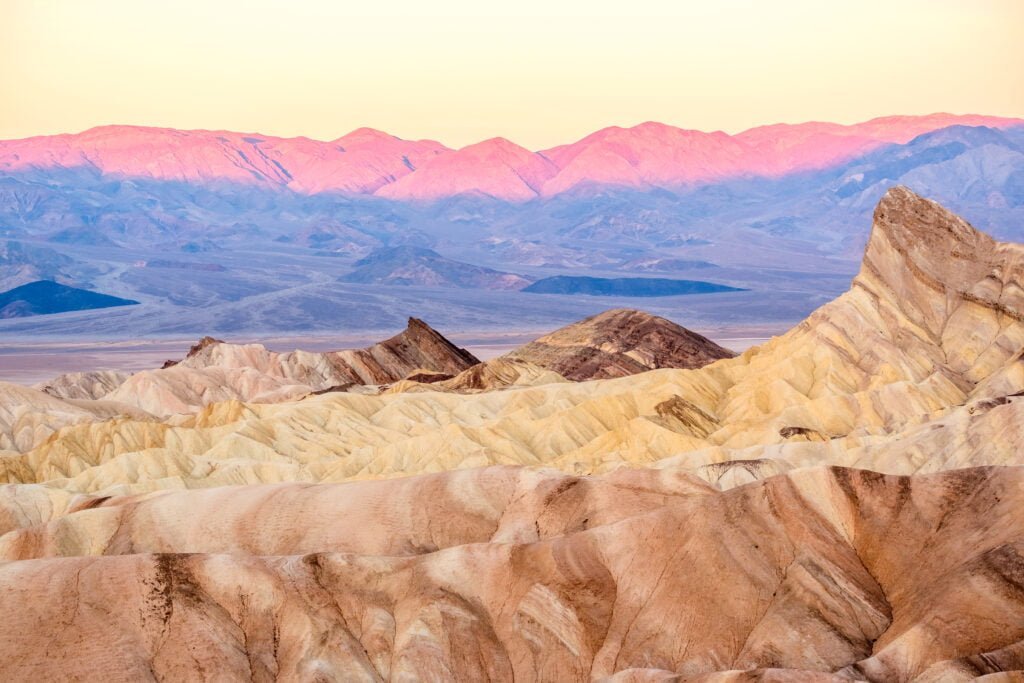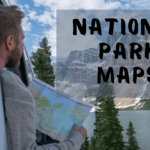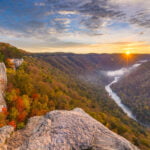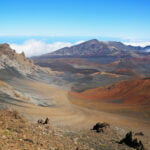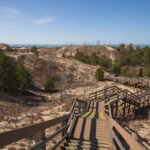Death Valley National Park
Welcome to Death Valley National Park, the largest national park in the lower 48 states, covering 3.4 million acres. Since its establishment in 1994, the park has been dedicated to protecting its diverse landscapes and offering visitors a unique and memorable experience. Death Valley presents a wide range of natural features, from vast sand dunes and snow-dusted peaks to sprawling salt flats and vivid badlands.
Entering Death Valley feels like entering a new dimension, with its record-breaking temperatures and stunning geological features drawing in those who love adventure and the outdoors. It hosts Badwater Basin, the lowest point in North America at 282 feet below sea level, and it recorded the hottest temperature on Earth at 130°F (54.4°C) in August 2020.
The park is full of fascinating sights, such as the Racetrack Playa, where rocks mysteriously move across the ground, and the beautiful Mesquite Flat Sand Dunes. For history buffs, the Harmony Borax Works offers a glimpse into the valley’s mining era.
Death Valley National Park is truly exceptional, providing a rich and diverse experience unlike any other. It’s a place where natural wonders and historical intrigue come together, inviting you to explore and appreciate the extraordinary diversity of our planet.
Location of Death Valley National Park
Death Valley National Park is a captivating expanse of desert landscapes nestled between the eastern California and the western edge of Nevada, in the United States. Spanning over 3.4 million acres, it is the largest national park in the lower 48 states. The park is part of the Mojave and Colorado Deserts Biosphere Reserve and offers a diverse range of topographical features, including rugged mountains, rolling sand dunes, and expansive salt flats.
Directions to Death Valley National Park
Death Valley National Park is located in eastern California and extends into Nevada. To get there:
- From Las Vegas, NV: Take US-95 North for about 115 miles to NV-374 West (Death Valley Junction). Continue on CA-190 West into the park.
For GPS navigation, use: Death Valley National Park, CA 92328.
Coordinates of Death Valley National Park
- Latitude: 36.5054° N
- Longitude: 117.0794° W
Scenery Death Valley National Park
The park’s unique geological features are a result of its location in the Great Basin. Death Valley is a long, narrow basin that descends to 282 feet below sea level at its lowest point, Badwater Basin, making it the hottest and driest national park in the United States. This extreme environment is home to an array of rare and unique plant and animal species that have adapted to thrive in these harsh conditions, contributing to the park’s ecological diversity.
The park’s location also played a significant role in its historical significance. Death Valley was once a major thoroughfare for pioneers and gold-seekers traveling to California during the Gold Rush era in the mid-19th century. Many of the park’s historical sites, such as the Harmony Borax Works and the Wildrose Charcoal Kilns, showcase remnants of this vibrant past.
Recreational opportunities abound in Death Valley National Park, where visitors can explore the park’s incredible terrain through activities like hiking, camping, and off-road driving. The park’s location provides a sense of isolation and remoteness, allowing visitors to marvel at the stark beauty of the desert and its remarkably clear night skies, perfect for stargazing. Death Valley National Park’s unique location and vast wilderness make it a must-visit destination for those seeking an unforgettable outdoor adventure.
Death Valley National Park Opening Times
Death Valley National Park is open year-round, 24 hours a day, providing visitors with the opportunity to explore the stunning landscapes and unique features of this captivating destination. However, it’s important to note that some areas and facilities within the park may have specific hours or be closed during certain times of the year.
Seasonal variations in weather conditions can affect the accessibility of some trails, roads, and facilities. For example, during the summer months, temperatures in the park can reach extreme highs, which may prompt temporary closures of specific trails for safety reasons. Additionally, some roads may become impassable due to winter snowfall or flash floods during rare rainstorms.
Wildlife protection efforts may sometimes lead to temporary closures or restricted access to certain areas in the park. This ensures that the park’s diverse and delicate ecosystems remain undisturbed, allowing visitors to continue enjoying the natural beauty of Death Valley.
To make the most of your visit, it’s highly recommended that you check the park’s official website or contact the visitor center for up-to-date information on the opening hours and current conditions of the areas you plan to explore. Planning your visit during the cooler months, between November and March, can provide a more comfortable experience, as temperatures are more moderate and most facilities and trails are accessible. Be prepared, stay informed, and enjoy the fascinating wonders that Death Valley National Park has to offer.
Visitor Centers and Facilities at Death Valley National Park
Death Valley National Park offers a range of facilities to ensure a comfortable and enjoyable visit for its guests. There are two primary visitor centers located within the park, each providing essential information, amenities, and services to make your trip a memorable one.
The Furnace Creek Visitor Center, situated in the heart of the park, serves as the main hub for information. Here, you’ll find park rangers ready to answer your questions, informative exhibits on the area’s geology, history, and ecology, as well as a well-stocked bookstore for your souvenir and educational needs. Restrooms and water filling stations are also available onsite. Nearby the visitor center, you’ll discover a scenic picnic area, ideal for a leisurely lunch surrounded by the park’s unique landscapes. However, there aren’t any playground facilities within the park.
The second visitor center, Stovepipe Wells, is located on the western side of the park. It offers similar services such as restrooms, information services, and displays showcasing the park’s features. Due to its smaller size, it doesn’t have the same range of facilities as the Furnace Creek Visitor Center. Nevertheless, it’s a useful and convenient stop for travelers in that area.
One limitation to consider is the absence of food services within these visitor centers. Therefore, it’s crucial to bring your own food supplies or visit the nearby restaurants in Furnace Creek and Stovepipe Wells Village.
To make the most of these facilities, plan your trip by stopping at one of these visitor centers early in your visit, and gather relevant information on the park’s highlights and safety guidelines. As temperatures can soar during the day, make sure to take advantage of the water filling stations and stay hydrated throughout your journey. Lastly, leave no trace by utilizing the provided trash receptacles and maintaining the park’s pristine environment for future generations to enjoy.
Accessibility at Death Valley National Park
Death Valley National Park is committed to making its diverse landscapes and attractions accessible for visitors with disabilities or mobility challenges. The park offers several accessible facilities, including the Furnace Creek Visitor Center, which features exhibits, restrooms, and parking designed for ease of use. Additionally, many of the park’s campgrounds and picnic areas are equipped with accessible tables and restrooms.
For those seeking outdoor exploration, Death Valley provides a variety of accessible trails and viewpoints. The Salt Creek Interpretive Trail, a boardwalk trail of 0.5 miles, offers an easy and enjoyable walk through a unique desert marsh. Moreover, the Harmony Borax Works Interpretive Trail features a paved path, allowing visitors to explore the historic ruins of a borax mining operation.
Some scenic overlooks, such as Zabriskie Point and Dante’s View, have wheelchair-accessible viewpoints, granting visitors the opportunity to marvel at the park’s breathtaking panoramas. However, it is essential to note that many of the park’s remote and rugged areas may present challenges for visitors with accessibility needs.
For visitors who require additional assistance, it is advisable to contact the park’s visitor center to obtain further information on specific accommodations and accessibility options. Death Valley National Park strives to create an inclusive experience for all, allowing everyone to appreciate the beauty and wonder of this remarkable destination.
Getting To Death Valley National Park
Getting to Death Valley National Park offers various options for travelers, with the closest airport being McCarran International Airport (LAS) in Las Vegas, Nevada, which is approximately 120 miles away. From there, you can rent a car and drive to the park. Another nearby airport is Los Angeles International Airport (LAX), about 275 miles away.
There is no public transportation directly into the park; however, you can take a Greyhound bus to nearby towns such as Beatty, Nevada, or Ridgecrest, California. From these towns, renting a car or hiring a taxi is possible to reach the park.
Driving routes to Death Valley include Highway 190, which provides access from the west and east, and Highway 374 from the north. The park is also reachable via Highways 178 and 127 from the south. Nearby towns and cities include Beatty, Pahrump, and Las Vegas in Nevada, and Lone Pine, Ridgecrest, and Furnace Creek in California.
Parking is available at various locations throughout the park, such as visitor centers, campgrounds, and popular trailheads. There are no parking fees; however, a park entrance fee is required. During peak visitation times, such as spring and fall, parking may become limited at popular attractions. It is recommended to arrive early to secure a spot and avoid the crowds.
Death Valley National Park Entrance Fees and Passes
Entering Death Valley National Park requires visitors to pay an entrance fee, which contributes to the maintenance and preservation of the park’s resources and facilities. The fees are as follows: $30 per vehicle, $25 per motorcycle, and $15 per individual (pedestrian or cyclist), all valid for a period of 7 days. To obtain a pass, visitors can either pay at the entrance stations or purchase a digital pass online through the official National Park Service website.
For frequent visitors or those planning on visiting multiple national parks, the America the Beautiful Pass is a great investment. Priced at $80 per year, this pass grants access to more than 2,000 federal recreation sites, including Death Valley. There are also discounts and exemptions available for seniors, disabled individuals, military personnel, and 4th-grade students, with specific passes catering to their needs.
Purchasing a park pass helps support the operations, infrastructure, and conservation efforts within Death Valley National Park. However, be aware that some remote areas of the park may not have entrance stations, so having a digital pass or purchasing it beforehand is recommended. Furthermore, additional permits may be required for particular activities such as backcountry camping, and reservations are necessary for campgrounds during the busy season.
Death Valley National Park Park Rules and Regulations
At Death Valley National Park, following the rules and regulations is essential to ensure the park’s preservation, visitor safety, and protection of wildlife. Responsible behavior is key to enjoying this unique landscape and maintaining its natural beauty for future generations.
One common violation is venturing off designated trails or driving on unauthorized roads, which can damage sensitive habitats and disrupt wildlife. To avoid this, make sure to stay on marked pathways and stick to authorized roads. Camping is only allowed in designated areas, so check the park map for approved campgrounds and avoid setting up camp in unauthorized spaces, helping to protect the park’s resources and ecosystems.
Feeding or approaching wildlife is strictly prohibited, as this can disturb their natural behavior and put both the animals and visitors in danger. Instead, observe and photograph animals from a safe distance. Similarly, collecting plants, rocks, or other natural features is not allowed; this ensures the preservation of the park’s unique environment.
Fires must be contained within established fire pits or grills in designated areas, as wildfires can be devastating to the park and its inhabitants. Dispose of trash responsibly, and follow the Leave No Trace principles to minimize your impact on the park.
By adhering to these rules and regulations, you’ll play an essential role in preserving Death Valley National Park, ensuring a safe and enjoyable experience for all visitors and protecting the stunning landscape and diverse wildlife for future generations.
Transportation Within Death Valley National Park
Discovering Death Valley National Park’s vast, diverse landscapes can be both an exhilarating and challenging experience. When considering transportation options, visitors must take into account factors such as accessibility, sustainability, and convenience.
For those who prefer the classic approach, driving a personal vehicle or a rental car offers flexibility and freedom to explore at your own pace. However, be aware that some remote areas may require a high-clearance or 4WD vehicle, and it’s essential to stay informed about road conditions.
Cycling is another excellent option for the adventurous and environmentally conscious traveler. Biking through Death Valley allows for a more intimate connection with the park’s natural beauty while reducing your carbon footprint. However, cyclists must be prepared for the park’s extreme temperatures, vast distances, and limited services.
Several hiking trails and backpacking routes cater to those who prefer to explore on foot. Ranging from short, accessible paths to multi-day treks, there’s a trail for every fitness level and interest. Keep in mind that hiking in Death Valley requires ample planning, awareness of weather conditions, and a self-sufficient mindset.
Regardless of your chosen mode of transport, it’s crucial to stay safe and respect the park’s fragile ecosystem. Popular routes include the Badwater Basin salt flats, the colorful Artist’s Palette Drive, and the scenic Dante’s View. With a range of transportation options available, visitors can curate their ideal Death Valley experience while preserving this unique landscape for generations to come.
Death Valley National Park Attractions
Death Valley National Park offers a plethora of fascinating attractions and must-visit locations. Here are five sites that should not be missed when exploring this vast, stunning park.
1. Badwater Basin: As the lowest point in North America at 282 feet below sea level, Badwater Basin is a surreal, otherworldly landscape. A vast expanse of salt flats stretches across the valley floor, creating a striking visual contrast. The best time to visit is in the cooler months between November and March, as summer temperatures can soar above 120°F. Be sure to bring plenty of water and sun protection as the basin offers little shade.
2. Zabriskie Point: Renowned for its spectacular views of the park’s golden badlands, Zabriskie Point is a must-see for any visitor. The undulating landscape, shaped by ancient lakebed deposits and erosion, makes this viewpoint a photographer’s dream. Sunrise and sunset are particularly magical times to visit when the light casts an enchanting glow on the landscape.
3. Mesquite Flat Sand Dunes: These majestic dunes, located near Stovepipe Wells, offer a unique and iconic landscape within the park. The dunes can reach heights of 100 feet and provide endless opportunities for hiking, photography, and sandboarding. The best time to visit is early morning or late afternoon when the sun casts dramatic shadows across the dunes and temperatures are more comfortable.
4. Dante’s View: This breathtaking overlook, perched over 5,000 feet above the valley floor, provides panoramic views of the Badwater Basin and surrounding mountains. The stark contrast between the salt flats and surrounding peaks is truly awe-inspiring. The best time to visit is in the cooler months, and morning or afternoon for the best light. Keep in mind that the road to Dante’s View is closed during the winter months due to snow and ice.
5. Ubehebe Crater: A testament to the park’s volcanic history, Ubehebe Crater is a large, 600-foot deep volcanic crater formed by a powerful steam explosion. The striking hues of red, orange, and brown make this a fascinating location to explore. The best time to visit is during the cooler months, as there is little shade around the crater. Be cautious when hiking around the rim, as the loose volcanic ash can be slippery.
One memorable experience at Death Valley was watching the sun dip below the horizon at Zabriskie Point, casting a warm glow on the badlands below. As the colors shifted from gold to pink and finally to a deep purple, it was a reminder of the park’s incredible beauty and diversity.
Recreational Activities at Death Valley National Park
Death Valley National Park offers a diverse range of recreational activities for visitors to enjoy, including trails and hiking, climbing, cycling, ranger programs, guided tours, and more. Each activity offers unique opportunities to experience the park’s incredible landscape and immerse oneself in its natural beauty.
Trails and Hiking: Death Valley National Park boasts over 1,000 miles of trails, with options for all fitness levels and interests. Hikers can explore canyons, sand dunes, and even a volcanic crater. Some popular trails include the Golden Canyon, Mesquite Flat Sand Dunes, and Badwater Basin. Trail difficulty varies, so it’s important to research and choose a route suited to your abilities. The park does not require permits for hiking, but it’s essential to carry plenty of water, wear appropriate clothing and sun protection, and avoid hiking during the hottest parts of the day.
Climbing: Death Valley offers opportunities for climbing and bouldering in remote areas with stunning views. Climbers are required to follow Leave No Trace principles and adhere to all park regulations. No permits are needed for recreational climbing, but all climbers should be experienced and prepared with proper equipment.
Cycling: Bicycles are allowed on all park roads and specific trails, offering an invigorating way to explore Death Valley. Cyclists should be prepared for extreme heat, have plenty of water, and be aware of vehicle traffic on roads. Helmets are highly recommended for safety.
Ranger Programs: The park offers a variety of ranger-led programs, including talks, walks, and evening presentations. These programs are a great way to learn about the park’s unique features, history, and wildlife. Programs vary seasonally, so be sure to check the park’s schedule for current offerings.
Guided Tours: For those interested in learning more about the park’s unique geology, flora, and fauna, guided tours are available. These tours are led by knowledgeable guides who can provide an in-depth and engaging experience. Several companies operate within the park, offering a range of tour options and customizable experiences.
Other Activities: Death Valley National Park offers opportunities for stargazing, birdwatching, and photography. With the park’s remote location and limited light pollution, stargazing is particularly spectacular. Birdwatching enthusiasts can spot over 350 different species, while photographers will be captivated by the park’s stunning landscapes.
In summary, Death Valley National Park offers a wide array of recreational activities that cater to diverse interests and fitness levels. Whether you prefer hiking, climbing, or exploring the park’s unique features through ranger programs and guided tours, there’s something for everyone to enjoy. Always be sure to come prepared, be aware of seasonal restrictions, and carry all necessary permits and equipment for a safe and memorable visit.
Best Times to Visit Death Valley National Park
The best time to visit Death Valley National Park varies depending on your preferences, priorities, and tolerance for extreme temperatures. The park is open year-round with a range of seasonal experiences.
Winter (December to February) offers the mildest temperatures, ranging from 40°F (5°C) to 70°F (21°C). This is the ideal time for hiking, exploring, and camping without enduring sweltering heat. However, some higher elevation roads and trails may be closed due to snow or ice. Winter months tend to have minimal crowds, providing a more peaceful experience. Wildlife sightings are also more frequent during this time when animals are active in search of food and water.
Spring (March to May) is a popular season for visiting Death Valley, especially when the wildflower bloom occurs, which typically peaks in late March to early April, depending on rainfall levels. The temperatures start to rise but remain comfortable for outdoor activities. Spring is also a good time for bird watching, as migratory birds pass through the park.
Summer (June to September) is the hottest period in Death Valley, with temperatures consistently exceeding 100°F (38°C) and sometimes reaching up to 120°F (49°C). While this may be too extreme for some visitors, it offers a unique experience to witness the park in its most iconic state. However, be prepared for limited outdoor activities and essential precautions to avoid heat-related risks. Most facilities, such as visitor centers and campgrounds, remain open during the summer but may have reduced hours.
Fall (October to November) sees a gradual decrease in temperatures, making it a favorable time for hiking, camping, and exploring the park’s landscapes. The cooler weather also attracts more visitors, but the crowd levels are still manageable.
In summary, the best time to visit Death Valley National Park depends on your preferences. If you prioritize comfortable temperatures and fewer crowds, plan your visit during the winter months. For wildflower blooms and pleasant weather, opt for spring. If you’re willing to brave the heat, summer offers a unique experience. And finally, if you want to enjoy cooler temperatures with some possible wildlife sightings, fall is a great choice.
Nearby Attractions to Death Valley National Park
Death Valley National Park is a captivating destination with a diverse array of attractions and activities that appeal to nature enthusiasts and history buffs alike. Discover the hidden gems that surround this natural wonder to make your visit an unforgettable experience.
First, consider exploring the ghost town of Rhyolite, located just 35 miles from the park’s Furnace Creek Visitor Center. Rhyolite was once a bustling gold mining town in the early 1900s but was eventually abandoned, leaving behind fascinating ruins and remnants of its past. Wander through the remnants of old buildings, such as the iconic Cook Bank Building and the Bottle House, which is made entirely of glass bottles. Rhyolite is open year-round, and there are no fees or reservations required.
Next, venture to the Trona Pinnacles, an otherworldly landscape located approximately 90 miles from the park. These unique geological formations, composed of over 500 tufa spires, create an almost extraterrestrial environment perfect for photography, hiking, or even stargazing. The Trona Pinnacles are accessible via a dirt road and open year-round with no entrance fees. However, keep in mind that the road may be impassable during periods of heavy rain.
Lastly, don’t miss the opportunity to visit the Ubehebe Crater, a 600-foot-deep volcanic crater situated within Death Valley National Park. Formed over 2,000 years ago by a massive volcanic explosion, this geological marvel can be experienced from the rim or by hiking down to the crater floor. The Ubehebe Crater is accessible year-round and included in the park’s entrance fee.
Incorporating these attractions into your visit to Death Valley National Park allows you to gain a deeper understanding of the region’s geology, history, and natural beauty. The main drawback is that these sites can be somewhat remote and may require extra driving or planning. However, the breathtaking landscapes and unique experiences they offer make them well worth the effort.
Tips for Visiting Death Valley National Park
When planning a visit to Death Valley National Park, timing is crucial. The best time to visit is during the cooler months between October and April, with temperatures ranging from the mid-60s to the mid-80s (Fahrenheit). This is also when the wildflower blooms can be witnessed, painting the desert landscape with vibrant colors.
Packing for Death Valley should include lightweight clothing, a wide-brimmed hat, sunglasses, sunscreen, and comfortable footwear. For photography enthusiasts, bring a camera with a polarizing filter to capture the stunning contrasts of the landscape. A tripod is also useful for long-exposure shots, particularly for capturing the dazzling stars in the night sky.
Safety precautions are essential when visiting Death Valley. Always carry plenty of water (at least a gallon per person per day) and avoid hiking during the hottest hours of the day. Be aware of potential hazards such as rattlesnakes, flash floods, and extreme heat. Inform someone of your itinerary and expected return time, especially if venturing off the main roads.
For a well-rounded Death Valley experience, consider the following itineraries:
– For first-time visitors: Start with a visit to the Furnace Creek Visitor Center to get an overview of the park. Then, explore popular sites such as Zabriskie Point, Dante’s View, and Badwater Basin – the lowest point in North America.
– For history buffs: Explore the park’s rich mining history by visiting the Harmony Borax Works, the Keane Wonder Mine, or the well-preserved ghost town of Rhyolite.
– For outdoor enthusiasts: Embark on a hike through the colorful rocks at Artists Palette, the breathtaking Mesquite Flat Sand Dunes, or the challenging Golden Canyon and Gower Gulch Loop.
– For off-the-beaten-path adventurers: Drive along the park’s scenic backcountry roads, such as the Titus Canyon, Racetrack Playa, or Eureka Dunes.
No matter your interests or experience level, Death Valley National Park offers a wealth of opportunities to explore its unique desert landscapes, fascinating history, and breathtaking vistas.
Camping and Lodging at Death Valley National Park
Death Valley National Park offers a diverse range of accommodations that cater to all types of visitors, be it solo travelers, couples, or large groups. These options vary in terms of location, comfort, and budget, ensuring that everyone can find a suitable place to stay during their visit.
Inside the park, there are two main lodging facilities: The Oasis at Death Valley and Stovepipe Wells Village. The Oasis is a luxury resort with the historic Inn at Death Valley and the family-friendly Ranch at Death Valley. Amenities include a spring-fed pool, fine dining, stables, and a golf course. Prices range from $200 to $500 per night, depending on the room type and season. The Stovepipe Wells Village provides more rustic accommodations, including a motel, RV park, and campground. It also offers a restaurant, saloon, and general store. Rates are generally more affordable here, falling between $100 and $200 per night.
Outside the park, visitors can find numerous accommodation options in nearby towns such as Beatty, Pahrump, and Lone Pine. These towns offer a mix of hotels, motels, campsites, and vacation rentals, catering to a range of budgets and preferences. Prices are typically lower than those inside the park, but the trade-off is a longer drive to reach the park’s attractions.
Camping is another popular choice for visitors to Death Valley National Park. There are nine campgrounds within the park, ranging from developed sites with amenities like restrooms and potable water to remote, primitive backcountry camping. Fees range from $4 to $36 per night, depending on the campground and services available.
To book lodging facilities within the park, reservations can be made through the respective facility’s website or by phone. Campgrounds are available on a first-come, first-served basis, except for Furnace Creek Campground, which requires reservations during the peak season (October to April).
In summary, accommodations in and around Death Valley National Park cater to various preferences and budgets. For a luxurious stay, consider The Oasis at Death Valley. For a more budget-friendly option, Stovepipe Wells Village, nearby towns, or camping within the park are excellent choices.
Food and Dining Options Death Valley National Park
Death Valley National Park offers a range of food and dining options to suit various tastes, budgets, and dietary preferences. Within the park itself, the primary on-site facilities for dining include the Stovepipe Wells Village Restaurant and the Panamint Springs Resort Restaurant. Both of these establishments serve American-style cuisine with options like burgers, sandwiches, salads, and breakfast items. Prices are moderate, and the quality is generally good given the remote location.
For a more upscale dining experience, The Inn at Death Valley, previously known as Furnace Creek Inn, offers the elegant Dining Room, which serves a variety of dishes, including steak, seafood, and vegetarian options. Prices are on the higher end, but the quality and atmosphere make it worth considering for a special treat.
Nearby restaurants outside the park boundaries are limited, but a short drive to towns like Beatty or Pahrump will yield additional choices, including Mexican and Italian cuisine, fast food, and local eateries. Prices and quality vary, so it’s recommended to check reviews before making a decision.
For those who prefer picnicking and self-catering, the park offers several designated picnic areas with tables and grills. These spots provide a lovely setting for enjoying a meal amidst the striking desert landscape. Remember to pack plenty of water, as well as food that can withstand high temperatures, and always adhere to the park’s leave-no-trace principles.
In summary, while dining options are somewhat limited within Death Valley National Park, visitors can still find a decent variety of meals, from casual fare to fine dining experiences. Planning ahead and considering self-catering options can also enhance your culinary journey in this unique and captivating destination.
Visitor Numebers Death Valley National Park
Death Valley National Park, known for its extreme temperatures and striking landscapes, experiences varying visitor numbers throughout the year. The peak season typically spans from November to April when the weather is cooler and more comfortable for exploration. During these months, average daytime temperatures range from 65 to 85 degrees Fahrenheit, making it an ideal time for hiking and sightseeing. Conversely, visitation drops significantly during the sweltering summer months, when temperatures can exceed 120 degrees Fahrenheit.
Visitor trends are primarily influenced by weather conditions, with cooler months attracting tourists in large numbers. This high influx of visitors can sometimes impact the overall experience due to increased wait times, crowded trails, and limited availability of lodging and camping facilities. Park management faces the challenge of maintaining facilities and implementing conservation efforts to ensure the park’s natural beauty is preserved for future generations.
To enjoy Death Valley National Park with fewer crowds, consider visiting during the shoulder seasons of October and May. Although temperatures can still be quite warm, visitors can take advantage of early morning and late afternoon explorations to avoid the hottest hours of the day. Additionally, mid-week visits are generally less crowded compared to weekends.
Regardless of visitor numbers, there is always an opportunity to make the most of your visit to Death Valley National Park. Choose lesser-known trails to explore, enjoy stargazing on clear nights, and take advantage of ranger-led programs to enrich your understanding of the park’s unique ecosystem and history. By planning ahead and remaining flexible, you can have an unforgettable experience while supporting the park’s ongoing conservation efforts.
History and Background of Death Valley National Park
Death Valley National Park, established in 1933 and expanded in 1994, is a captivating expanse of desert wilderness covering over 3.4 million acres in California and Nevada. The park’s history is shaped by its diverse geological formations, unique ecosystems, and the legacies of various human inhabitants.
One of the park’s key historical events was the westward migration of pioneers during the Gold Rush. In 1849, a group of prospectors took a shortcut through Death Valley, hoping to reach California’s gold fields. The harsh conditions and treacherous terrain resulted in the loss of lives, wagons, and supplies, giving the valley its ominous name. Despite the challenges, mining continued to play a significant role in the area’s development, with various minerals, including borax, being discovered and extracted since the 1880s.
Death Valley is also home to various Native American tribes, most notably the Timbisha Shoshone, who have lived in the region for over 1,000 years. The tribe’s traditional knowledge, culture, and practices are an essential aspect of the park’s heritage and identity.
Today, the National Park Service (NPS) manages Death Valley National Park to protect its natural and cultural resources while providing recreational and educational opportunities for visitors. Ongoing preservation efforts include habitat restoration, monitoring of endangered species, and maintaining the park’s numerous historical sites. The park offers various ranger-led programs and exhibits at the Furnace Creek Visitor Center, allowing visitors to learn about the area’s geology, ecology, and history.
In conclusion, Death Valley National Park holds immense significance both as a testament to the resilience of nature and the indomitable human spirit. Its rich history, cultural connections, and ongoing preservation efforts continue to captivate and inspire visitors from all around the world.
Flora and Fauna at Death Valley National Park
Death Valley National Park is a treasure trove of diverse and fascinating wildlife and plant species, offering visitors a unique opportunity to explore an array of ecosystems and habitats. Despite its arid and harsh conditions, the park is home to over 1,000 species of plants and a variety of wildlife, including birds, reptiles, and mammals. The park’s mission is to preserve these natural resources and promote their appreciation among visitors.
Within the park, you’ll find several ecosystems, such as the salt pans, sand dunes, and badlands. Each of these ecosystems supports distinctive plant and animal species that have adapted to the extreme conditions. Some notable plants include the rare Death Valley pupfish, which can only be found in the park’s saline lakes and springs, and the Joshua tree, a distinctive desert plant that thrives in the park’s high elevations.
The park’s diverse wildlife includes bighorn sheep, coyotes, black-tailed jackrabbits, and over 300 species of birds. Reptiles such as the desert tortoise, chuckwalla, and sidewinder rattlesnake also call Death Valley home.
To enjoy the park’s flora and fauna responsibly and safely, visitors should maintain a respectful distance from wildlife and never feed them. Observing animals from a distance ensures their safety and allows them to continue their natural behaviors undisturbed. It’s also important to stay on designated trails to minimize harm to plant life and sensitive habitats.
When exploring the park, consider visiting during early morning or late afternoon hours, as many animals are more active during these times. If you’re specifically interested in birdwatching, Furnace Creek and Scotty’s Castle areas are known for their diverse bird populations. Don’t forget to bring binoculars and a camera to capture the incredible sights you’ll encounter while exploring the remarkable ecosystems of Death Valley National Park.

